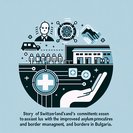
Geneva-based International Air Transport Association (IATA) released its September 2025 traffic statistics on 30 October. Total demand, measured in revenue-passenger-kilometres, rose 3.6 % year-on-year, with international traffic up 5.1 %. European carriers— including SWISS and Edelweiss—saw demand rise 4 %, while capacity expanded 4.4 % and the load factor held above 85 %.
IATA director-general Willie Walsh highlighted that 90 % of the month’s growth came from international sectors and that forward schedules for November show another 3 % seat expansion. For Swiss corporates, the figures confirm that premium-heavy long-haul markets out of Zurich and Geneva are recovering steadily despite supply-chain constraints. Capacity discipline, however, remains tight; average load factors in Europe exceeded 86 %, which means popular business-class cabins will stay full and flexible fares high over the year-end peak.
Geneva’s status as a multilateral hub is again visible in the data: traffic flows between Europe and Africa (+6.1 %) and Europe and the Middle East (+6.2 %)—two regions that feed UN and NGO travel demand—out-paced the global average. Asia-Pacific growth of 7.4 % suggests that Swiss companies with manufacturing footprints in China, Japan and ASEAN can expect better seat availability but continued elevated fares, as capacity (6.1 %) still lags demand.
Practical implications for mobility managers include (1) securing winter allocations on key routes early, (2) budgeting for marginally higher ticket prices, and (3) reminding travellers that load factors above 80 % leave little room for last-minute changes. With European carriers planning only modest incremental capacity, any weather- or labour-related disruption could quickly ripple through Swiss hubs. IATA’s next data release in late November will confirm whether the upward trend extends into Q4, traditionally Switzerland’s busiest season for financial-services travel.
Overall, the figures underscore that global air connectivity serving Switzerland is well into its post-pandemic recovery, but travellers should expect crowded flights and minimal slack through the winter timetable.
IATA director-general Willie Walsh highlighted that 90 % of the month’s growth came from international sectors and that forward schedules for November show another 3 % seat expansion. For Swiss corporates, the figures confirm that premium-heavy long-haul markets out of Zurich and Geneva are recovering steadily despite supply-chain constraints. Capacity discipline, however, remains tight; average load factors in Europe exceeded 86 %, which means popular business-class cabins will stay full and flexible fares high over the year-end peak.
Geneva’s status as a multilateral hub is again visible in the data: traffic flows between Europe and Africa (+6.1 %) and Europe and the Middle East (+6.2 %)—two regions that feed UN and NGO travel demand—out-paced the global average. Asia-Pacific growth of 7.4 % suggests that Swiss companies with manufacturing footprints in China, Japan and ASEAN can expect better seat availability but continued elevated fares, as capacity (6.1 %) still lags demand.
Practical implications for mobility managers include (1) securing winter allocations on key routes early, (2) budgeting for marginally higher ticket prices, and (3) reminding travellers that load factors above 80 % leave little room for last-minute changes. With European carriers planning only modest incremental capacity, any weather- or labour-related disruption could quickly ripple through Swiss hubs. IATA’s next data release in late November will confirm whether the upward trend extends into Q4, traditionally Switzerland’s busiest season for financial-services travel.
Overall, the figures underscore that global air connectivity serving Switzerland is well into its post-pandemic recovery, but travellers should expect crowded flights and minimal slack through the winter timetable.







